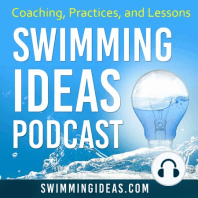27 min listen
SIP 048: The science behind progressions
ratings:
Length:
20 minutes
Released:
May 15, 2016
Format:
Podcast episode
Description
USA Swimming has this article linked to their Learn To Swim page at www.usaswimming.org http://www.usaswimming.org/_Rainbow/Documents/cad48e4f-0aab-4cea-8fba-0c376f556559/BCDPTF%20Position%20Paper%203a.pdf We're going to look specifically at this portion: " Moving and Learning Recent neurological research links movement to learning and memory. Since neurologists now agree that active movement is scientifically linked to intellectual development, how early should movement training begin? Babies are born with most of their neurons, billions. But they have few interconnections (synapses) between the neurons. As a baby moves and interacts with his world, the impulses flowing through his neurons stimulate the cell fibers to grow more branches and twigs reaching out to other neurons. When neurons are stimulated through movement, they develop interconnections (synapses). The more interconnections, the more capable the child is of learning (Whitehead). Interaction or communication between the neurons is necessary for learning to take place. Neuroscientists at University of California at Irvine discovered that active movement activates the release of BDNF, a brain-derived neurotrophic factor (Kinoshita 1999). BDNF is a protein that acts on certain neurons in the brain; it supports the growth, function, and survival of these neurons and synapses in the hippocampus, cerebral cortex, and the basal forebrain. These are areas of vital learning, memory, and higher reasoning (Whitehead). Every time a synapse is used, it becomes stronger and easier to send messages in the future. Every time a movement is repeated, less energy is used to repeat it in the future. As an infant repeats movements, the brain groups those movements together in a neural memory. A newborn has very few memories stored in his synapses. As he moves and interacts with his world, his nervous system accumulates more neural memories (Ayers 1991). A child has neural memories for everything he can do. These sensory/motor memories create an internal picture of the body. This body image is stored in the child's nervous system. The child's brain refers to this internal picture to plan his movements. The more accurate the internal body image, the better able a child is to navigate unfamiliar movements (Ayers 1991). By giving a child many varied sensory experiences like the active movement in swimming, his movement experiences become more plentiful and diverse, resulting in a more developed internal body picture. However without this information, the child would not know where the parts of his body are or how to spontaneously move from one place to another without conscious planning. " Varied movement in swimming produces automatic responses later. If we practice repetitive motions in different and varied ways, when we go to move through the water that motion will be done quicker, better, and automatically without thought: automatic response when under duress, or a "fight or flight mode." We use progressions of increasing difficulty so when we go to do the activity it is done well without conscious thought. Free play Kicking motions Position 11 Front glides supports Back glide #1 take-away from the article? Loving, slow, fun environment is significantly be
---
Send in a voice message: https://anchor.fm/swimmingideas/message
Support this podcast: https://anchor.fm/swimmingideas/support
---
Send in a voice message: https://anchor.fm/swimmingideas/message
Support this podcast: https://anchor.fm/swimmingideas/support
Released:
May 15, 2016
Format:
Podcast episode
Titles in the series (100)
SIP 019: How we train our Staff by Swimming Ideas Podast
